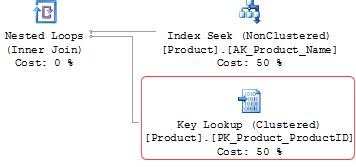A Bookmark lookup, by any other name…
I think I may have confused some people by talking about bookmark lookups. I’ll attempt to clarify things.
The operator that I’m talking about is the one that fetches extra columns from the clustered index when the nonclustered index that’s used to retrieve the rows doesn’t have all of the columns required.
In SQL 2000, that operator appeared in the execution plan as a bookmark lookup and it appeared as follows:

In SQL 2005, the name was changed, and the bookmark lookup no longer appeared in the execution plan. In it’s place appeared a clustered index seek, joined back to the original index seek by a nested loop join. It appeared as follows (the highlighted operator is the ‘bookmark lookup’)

This change made it harder to see what was going on as clustered index seeks are usually considered ‘good’. The trick to see if it is actually a ‘bookmark lookup’ is to look at the objects involved. When the nonclustered index seek and the clustered index seek are both on the same table, then it’s a ‘bookmark lookup’
I don’t recall what this appeared as when the base table was a heap, not a cluster.
In SQL 2005 SP2, the name of the operator was changed again, now appearing as a key lookup (when the base table has a clustered index) or a RID lookup (when the base table is a heap). It now looks like this:

The thing to note is that it’s not the version of the server that’s important. The format of the XML for the exec plan has not changed since SQL 2005 RTM (I can and have created a .sqlplan file from SQL 2008 and opened that file in SQL 2005’s management studio).
It’s the version of management studio that affects how the execution plans are displayed. If the server is SQL 2005 SP3, but the client tools are still RTM, the bookmark lookup will appear as a clustered index seek. Another reason to patch the client as well as the server
I hope that clears up some of the confusion around the naming. So, in future, what should I refer to this as? A bookmark lookup? A Key lookup?